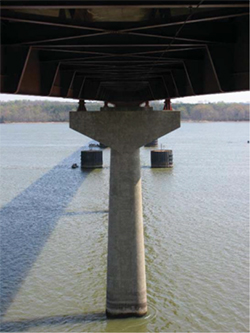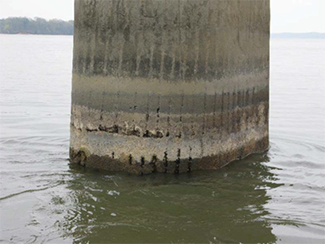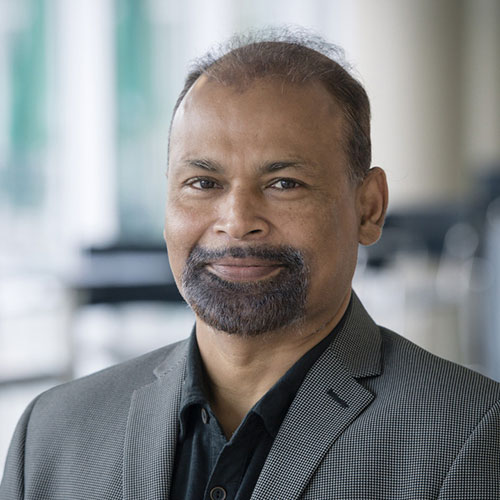An ancient roadway is getting a 21st century upgrade.
For more than 2,000 years, people have traveled along the Natchez Trace—a 444-mile corridor through Tennessee, Alabama and Mississippi. Today, travelers along the Alabama portion of that route rely on the John Coffee Memorial Bridge, a 60-year old structure that could be nearing the end of its lifespan.
Nasim Uddin, Ph.D., a professor and graduate program director in the Department of Civil, Construction, and Environmental Engineering, has received funding from the National Science Foundation and the U.S. Department of Transportation to conduct research for the thorough inspection and damage detection of the bridge to help determine its future.
“In the mid-20th century, the United States built thousands of bridges as it expanded its highway system,” Uddin said. “Those bridges were intended to last 50 or 75 years, so today, the lifespan they were designed for is over, and we are seeing these structures beginning to become unsafe.”
 Thousands of bridges built during the U.S. infrastructure boom of the mid-20th century are showing their age. Uddin's team of researchers hopes to use modern technology to make inspections more efficient and safer.In recent years, Uddin has attempted to develop modern methods to address the challenges of decaying infrastructure. Using drones, robots, and other modern methods, he and his team of researchers have developed systems for inspecting bridges quickly and safely.
Thousands of bridges built during the U.S. infrastructure boom of the mid-20th century are showing their age. Uddin's team of researchers hopes to use modern technology to make inspections more efficient and safer.In recent years, Uddin has attempted to develop modern methods to address the challenges of decaying infrastructure. Using drones, robots, and other modern methods, he and his team of researchers have developed systems for inspecting bridges quickly and safely.
“Nowadays, there is uncertainty about how to proceed with the repair and rehabilitation of the bridge structures as too many of the bridges requiring repairs and rehabilitations.” Uddin said. “Do they attempt to repair the bridge and continue using it? Or do they build a new bridge which can be unaffordable under most of the circumstances? Using traditional methods, a full, comprehensive inspection of the bridge would take years, and they don’t have that kind of time. So they began looking for an innovative way to shorten the process.”
Following a nationwide search, the DOT/FHWA awarded HPtech (Senior VP: Dr. Mohammad Khan) a task order that included Uddin’s team, Missouri S&T (Prof. Genda Chen), and EnrGies Inc. (Mr. Steve Pierce), for the bridge inspection contract. This fall, the team initiated the project, utilizing advanced inspection devices onboard drones and robots to meticulously examine every square inch of the mile-long structure. “We will use drones equipped with cameras to inspect all 36 concrete piers to identify areas where the concrete is showing damages,” Uddin said. “Once we have scanned the entire bridge, we will identify the 10 worst piers, and the team will deploy climbing robots that will allow us to analyze the depth and the extent of the damages.”
 To do that, the robots will use a type of ultra-sound technology as well as ground-penetrating radar (GPR). “Any concrete structure will develop cracks over time, just like you see in sidewalks or driveways,” Uddin said. “But in a structure like a bridge, it is hard to tell if the crack is just on the surface. In that way, it is like a cancer in the body. Is it a blemish on the surface, or has it spread through the structure?”
To do that, the robots will use a type of ultra-sound technology as well as ground-penetrating radar (GPR). “Any concrete structure will develop cracks over time, just like you see in sidewalks or driveways,” Uddin said. “But in a structure like a bridge, it is hard to tell if the crack is just on the surface. In that way, it is like a cancer in the body. Is it a blemish on the surface, or has it spread through the structure?”
Uddin, who has spent several years researching methods for inspecting bridges, notes that this is the first time he has applied these methods on a project of this scale. Previously, under NSF and DOT initiatives, the focus was primarily on proving concepts and demonstrating innovative techniques.
“I’m more excited about this project than any I’ve worked on for two key reasons," he says. "First, some of the research I’ve conducted with students over the years will finally be implemented. Second, it’s an opportunity for the average ‘Joe on the street’ to see how cutting-edge drone and robotic technologies are being used to deliver real-world benefits. As academicians, we often develop ideas and technologies and then move on, leaving the commercial sector to further develop them. The average taxpayer funds much of this research, but they rarely see it applied in ways that directly impact their lives.”
